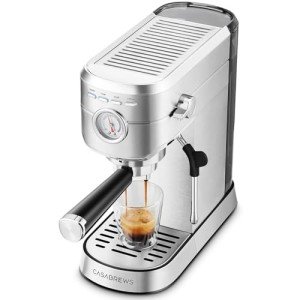The Art of Italian Espresso Machines: A Brewed Tradition
Italian espresso machines are not simply devices; they are an important part of Italy's abundant coffee culture, representing a mix of artistry, engineering, and design. Coffee enthusiasts around the globe acknowledge the value of high-quality espresso, a staple of Italian life and cuisine. This article explores the history, mechanics, types, and aspects to think about when buying an Italian espresso machine, showing the depth of this cherished beverage and its developing methods.
History of Espresso Machines
The espresso machine's evolution dates back to the early 20th century in Italy, where coffee was not merely a drink however an important social ritual. The initial attempts to brew espresso begun with simple, stove-top designs, slowly progressing into complex machines that might reproduce the ideal brew.
- 1901-- The First Espresso Machine: The first steam-powered espresso machine, referred to as the "Ideale," was established by Luigi Bezzera. This equipment marked a turning point in espresso brewing.
- 1938-- The Lever Machine: The introduction of the lever machine made it easier to control the pressure utilized in espresso extraction, enhancing taste consistency.
- 1947-- The Automatic Machine: Reaching more consumers, Gaggia introduced the very first automatic espresso machine, additional popularizing espresso bars.
- 2007-- The Digital Age: Technological developments led to the birth of completely programmable machines, enabling users to tailor their developing settings to accomplish a tailored coffee experience.
Secret Features of Italian Espresso Machines
Italian espresso machines embody accuracy, workmanship, and innovation. Here are some crucial components that highlight their significance:
| Feature | Description |
|---|---|
| Boiler Type | Determines how heat is generated and maintained. Common types include single boiler, dual boiler, and heat exchanger. |
| Group Heads | Where the coffee is brewed; commercial machines frequently have numerous group heads for performance. |
| Pressure Control | Crucial for attaining the ideal espresso; most machines operate at 9 bars of pressure. |
| Frothing Capabilities | The steam wand permits for milk frothing, vital for drinks like cappuccino and latte. |
| Construct Quality | The materials utilized (stainless steel, brass, etc) impact sturdiness and heat retention. |
Types of Italian Espresso Machines
Picking the best machine depends upon user choices, budget, and intended use. Below are the primary kinds of Italian espresso machines:
Manual Espresso Machines
- Pros: Offer complete control over the developing procedure, permitting a tailored touch.
- Cons: Require ability and practice, can be labor-intensive.
Semi-Automatic Machines
- Pros: Provide a balance in between automatic and manual procedures; users manage water circulation.
- Cons: Can have a steeper learning curve than fully automatic machines.
Completely Automatic Machines
- Pros: Simplify the brewing procedure with push-button operations; ideal for beginners.
- Cons: May compromise some of the nuances of manual developing.
Super-Automatic Machines
- Pros: Grind, tamp, brew, and froth automatically; hassle-free for hectic way of lives.
- Cons: Less control over the developing variables, potential for a less genuine espresso experience.
Buying Guide: Factors to Consider
Picking the ideal Italian espresso machine can be challenging, but thinking about the following factors can simplify the decision-making procedure:
- Budget: Italian espresso machines range from affordable to high-end models, so set a budget upfront.
- Use Frequency: Evaluate how often you will use the machine; day-to-day users might want a more durable choice.
- Area: Measure your kitchen or counter space; some machines can be big and need adequate clearance.
- Maintenance: Consider ease of cleaning; machines with removable parts or integrated cleansing features may lower maintenance.
- User Skill Level: Beginners may choose fully or semi-automatic machines, while skilled baristas can manage manual machines.
- Brand Reputation: Research brands known for quality, such as Breville, Gaggia, and La Marzocco.
Popular Italian Espresso Machine Brands
Italian craftsmanship is renowned for producing a few of the very best espresso machines worldwide. Here are top brands worth considering:
- Gaggia: Known for its home espresso machines and affordability.
- La Marzocco: A superior brand name known for its commercial-grade machines and innovative innovation.
- Rancilio: Renowned for its resilient construct and professional-quality machines suitable for home and commercial use.
- Sage/Breville: Offers advanced features and easy to use styles, best for both novices and lovers.
FAQs
What is the distinction in between espresso and routine coffee?
Espresso is a focused coffee brewed by forcing hot water through finely-ground coffee under pressure. It has a thicker consistency, richer flavor, and greater caffeine concentration than regular coffee.
Can I make milk-based drinks with an espresso machine?
Yes, numerous Italian espresso machines come with a steam wand to froth milk for drinks like coffees, lattes, and macchiatos.
How frequently should I clean my espresso machine?
Routine upkeep is important. Generally, a comprehensive cleaning is advised every couple of weeks, while descaling must be done every 1 to 3 months, depending on water firmness.
What is the ideal pressure for developing espresso?
The perfect pressure for brewing espresso is around 9 bars. Top Espresso Machines guarantees the optimum extraction of tastes from the coffee premises.
Are more expensive machines worth the investment?
Higher-end machines typically use much better products and innovation, providing improved resilience and more consistent results. For severe coffee fans, purchasing a great machine can raise the espresso experience significantly.
Italian espresso machines are far more than mere developing devices; they are a celebration of a cultural custom that has influenced coffee intake worldwide. With different models available to fit any user's requirements-- ranging from novices to experienced baristas-- there is an Italian espresso machine completely suited for everybody. As you embark on your espresso journey, comprehending the history, mechanics, and alternatives will enhance your experience and appreciation for this time-honored drink. Whether you seek to recreate a coffee shop ambiance in your home or refine your brewing technique, these machines can delivering memorable cups of espresso decorated with the rich history of Italian coffee culture.

